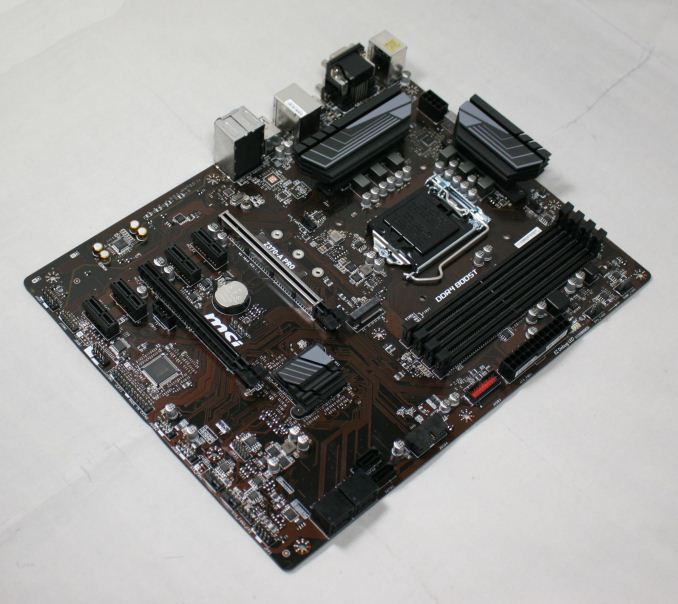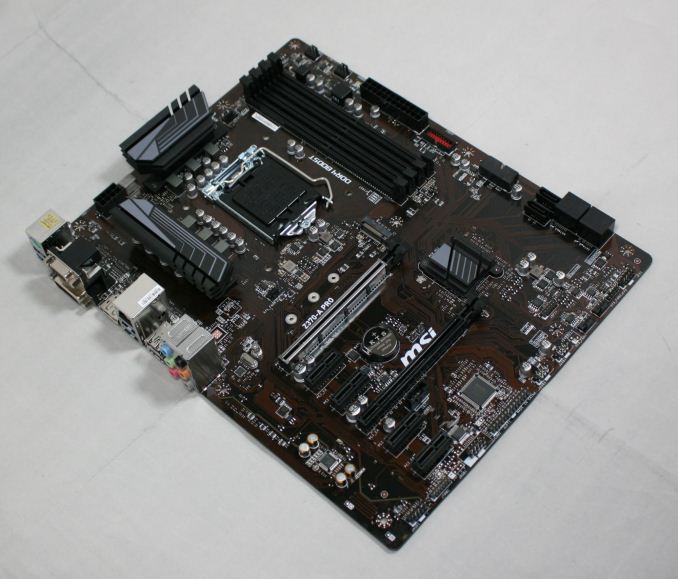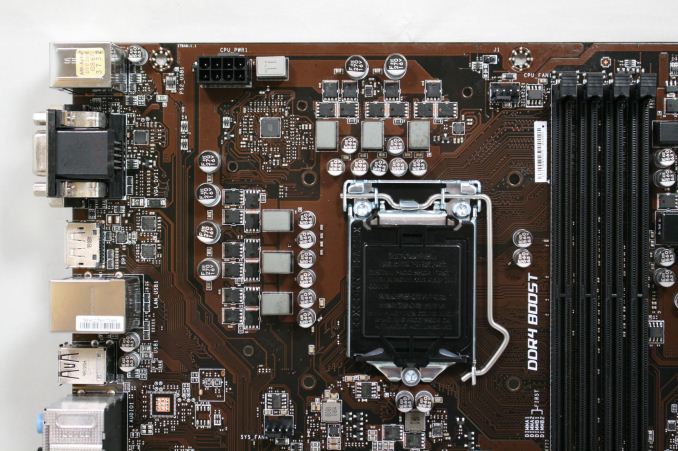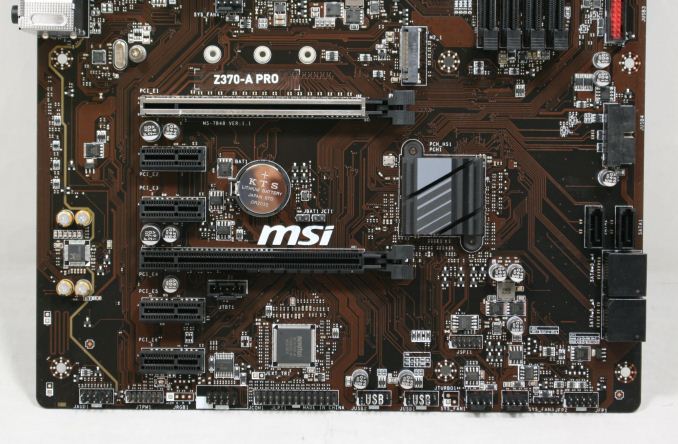The MSI Z370-A Pro Motherboard Review: Entry Level Business (And Pleasure)
by Joe Shields on September 11, 2018 8:00 AM EST- Posted in
- Motherboards
- MSI
- Coffee Lake
- Z370
- i7-8700K
- Z370A-Pro
- Pro Series
Visual Inspection
MSI's Z370-A Pro hails from their Pro lineup of motherboards intended for business (as opposed to a gaming focused product). The Pro series is a way to offer users an enthusiast class motherboard but without all the bells and whistles found in the other segments. Right off the bat, users should easily see how MSI makes up the basics on a $110 motherboard: a single M.2 slot, and a power delivery system that should be suitable for all CPUs. But on the flip side, it is missing some modern connectivity in USB 3.1 ports. Styling also takes a back seat in the Pro lineup with a more basic black/brown PCB color to start instead of the typical black many are more familiar with.
While this may sound negative, the fact is the board isn't intended for users who want the bling. It is intended for professional use and will typically be housed in a case without a window or simply hidden away regardless. The positives in this are the lower cost of the board (~$110) compared with the enthusiast segment priced much higher.
MSI still placed LEDs on the board, but as in the case of the Z270-A Pro, they are all white LEDs with several located by the audio section illuminating the separation line while there are others located on the corners of the board - all located on the back side of the board. The LED patterns are controlled through the MSI Mystic LIght application. Also worth noting here is MSI does not include a RGB header on the board for additional lighting.
Moving on to fan headers, there are a total of six found in various locations on the board. Towards the upper right-hand corner by the CPU socket and DRAM slots is a 4-pin CPU fan (all headers are four-pin), as well as the pump fan and a system fan header. The bottom part of the board has two more system fan headers with the last one located above the M.2 slot. All headers support both PWM and DC modes for control. the documentation does not state if any of the headers are high powered.
The power delivery system used on the Z370-A Pro has six total phases handled by the UPI Semiconductor uP9508 hybrid PWM. Judging by the appearance the six phases break down into a 4+2 combination (CPU and iGPU). While not the most robust solution we have seen, it handled the i7-8700K without issue, even while overclocked so it's going to be plenty for 'pro' users as well.
Sliding over to the right side of the board we are able to see the four DRAM slots on the right able to support up to 64GB of DDR4 RAM with speeds to DDR4-4000. Going left to right we see the six SATA ports and two USB 3.0 headers. Next to them is the 24-pin ATX connector along with the four debug LEDs that cover Boot, VGA, DRAM, and CPU issues upon boot. Finally to the right of them are a system fan and pump headers.
Zooming in a bit on the SATA ports we are able to see four of them placed horizontal (SATA 3-6) and two vertical (SATA 1-2). The board supports RAID 0, 1, 5, and 10 through these ports. Worth noting here is SATA 1 port will be disabled when an M.2 SATA SSD module is installed in the M.2 slot.
The bottom half of the board houses the audio, PCIe and chipset, as well as several IO headers across the bottom. Starting with audio, the Z370-A Pro uses a Realtek ALC892 codec which while not the latest and greatest, should still be able to provide 7.1 channel audio for the user. Surrounding the non-shielded chip are four Chemicon audio caps dedicated to the front output.
The PCIe setup contains a total of six ports, two full-length intended for video cards, and four x1 slots for other peripherals (or for mining as MSI states this board is also optimized for cryptocurrency mining). The primary GPU slot is reinforced to help protect cards against bending and EMI interference and runs at x16 while the second full-length slot is not and uses x4 lanes from the chipset. This configuration allows for Crossfire multi-GPU setups, but not SLI due to its x8 slot requirement.
| MSI Z370-A Pro CPU PCIe Layout | ||
| 16-Lane Single |
16-Lane Dual |
|
| PCIe 1 | @x16 | @x16 |
| PCIe 4* | x4 | @x4 |
| SLI | - | No |
| Crossfire | - | 'Yes' |
* Not CPU connected but used in Crossfire
@ = Preferred slot(s)
Across the bottom of the board are several headers ranging from front panel audio on the left, two USB 2.0 ports in the middle, two system fan headers, as well as dual front panel headers.
The back panel IO has a relatively full set of ports consisting of four USB 3.0 ports, two USB 2.0 ports, VGA, DVI-D and Displayport outputs for video. The network is managed by a Realtek RTL8111H Gigabit LAN controller and also includes a 6-plug audio stack. About the only thing missing back here are USB 3.1 ports of any kind.
- PS/2 Mouse/Keyboard
- 4 x USB 3.0
- VGA
- DVI-D
- DisplayPort
- RJ-45 port (Realtek)
- 2 x USB 2.0
- 6-plug audio stack
In the Box
The accessory stack includes what is needed to get started from SATA cables to guides and disks. A complete list is below.
- Quick Installation Guide, User Guide, Support CD
- I/O Plate
- 2 x SATA cables


























12 Comments
View All Comments
PeachNCream - Tuesday, September 11, 2018 - link
Visual Inspection, 1st Paragraph - "Off the bat, users should be how MSI makes up the basics on a $110 motherboard:"That line needs help.
halcyon - Tuesday, September 11, 2018 - link
Really entry level indeed. My MSi Z370 Pro crapped at ~175W load, even with extra VRM cooling. Upgraded to more expensive Asrock Taichi Z370 and OC is so much more stable at higher loads.imaheadcase - Tuesday, September 11, 2018 - link
That doesn't sound like the motherboard at all.qlum - Tuesday, September 11, 2018 - link
about the vrm's being sufficient for overclocking while the system may not downright crash or throttle with your load does not mean they are sufficient to sustain such overclock for a user.the vrm may run very hot, enough so to seriously impect the lifespan of the components. the 'heatsinks' are not that great at dissipating the heat but have enough mass to keep the vrm cool enough for some time until it does overheat. often cases do not provide a lot of airflow over the vrm resulting in higher temperatures. Some workloads like blender can be very stressfull over a longer peroid of time
So basically just because it keeps running the overclock in your test does not really mean the motherboard is able to sustain such overclock for daily use.
timecop1818 - Tuesday, September 11, 2018 - link
daily use overclocking is fucking retarded anyway. the stuff is fast enough, if you want it faster buy something that will be faster, no need to run stuff out of spec.PeachNCream - Tuesday, September 11, 2018 - link
So much of this! Overclocking is interesting, maybe a learning experience, but of little practical use and doing so results in unnecessary expenses from a cascade of additional problems that must be mitigated with components that would otherwise never have been needed to begin with. It creates perceptions like these about VRM cooling or about the necessity of 1KW power supplies. Have fun with it, but if you're working on some sort of task that you can't afford to lose or redo, then don't overclock your computer.Death666Angel - Tuesday, September 11, 2018 - link
So where can I buy a 5.2GHz Intel CPU then? Apart from the fun of maxing out component, you can attain results with overclocking, that you can't buy "in spec" from Intel or AMD.mischlep - Tuesday, September 11, 2018 - link
"The rear IO consists of three video outputs (VGA, DVI-D, and HDMI) "This motherboard has Displayport, not HDMI.
Ryan Smith - Tuesday, September 11, 2018 - link
Thanks!gobaers - Tuesday, September 11, 2018 - link
I would posit that the blain black/brown scheme is exactly why this *would* win a beauty contest. I'm not a 11yo seeking flashing lights, I find most high end component design to be garish and off-putting.